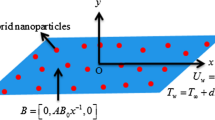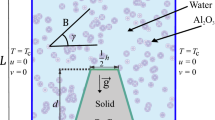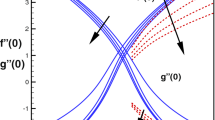Abstract
This article studies the impact of multi-nanoparticles on the entropy generation where heat transfer in Oldroyd-B fluid is subjected to Joule heating and heat generation. \({{\text{C}}}_{2}{{\text{H}}}_{6}{{\text{O}}}_{2}\) is assumed to obey the constitutive behavior in the context of the Oldroyd-B model. Three types of nanoparticles (\({{\text{Al}}}_{2}{{\text{O}}}_{3},{{\text{TiO}}}_{2}\) and \({{\text{SiO}}}_{2}\)) are assumed to be dispersed simultaneously in \({{\text{C}}}_{2}{{\text{H}}}_{6}{{\text{O}}}_{2}\). The numerical scheme is used for the numerical simulations and simulations are observed and various predictions are made. The dynamics of entropy generation versus relaxation and retardation times. Momentum relaxation time is helpful in controlling entropy generation. It is also observed that \({{\text{C}}}_{2}{{\text{H}}}_{6}{{\text{O}}}_{2}\) with \({{\text{Al}}}_{2}{{\text{O}}}_{3}\) has minimum entropy generation relative to \({{\text{C}}}_{2}{{\text{H}}}_{6}{{\text{O}}}_{2}\) with \({{\text{Al}}}_{2}{{\text{O}}}_{3}\) and \({{\text{TiO}}}_{2}\) and \({{\text{C}}}_{2}{{\text{H}}}_{6}{{\text{O}}}_{2}\) with \({{\text{Al}}}_{2}{{\text{O}}}_{3},{{\text{TiO}}}_{2}\) and \({{\text{SiO}}}_{2}\). Relative to hybrid and mono-nanoparticles, the highest wall shear stresses are noticed in \({{\text{C}}}_{2}{{\text{H}}}_{6}{{\text{O}}}_{2}\) with tri-nanoparticles is observed. Momentum retardation time enhances entropy generation. Therefore, it is recommended not to use fluid with Oldroyd-B behavior in mechanisms where entropy generation is not required. In mechanisms where entropy generation is not required, the base fluid or nanofluid should not be heat-generating because heat generation helps in enhancing the generation of entropy. However, heat-absorbing fluid would be favorable for the minimization of entropy.












Similar content being viewed by others
References
Ellahi R, Zeeshan A, Shehzad N, Hussain A, Sait SM. Mixed convection of two layers with radiative electro-magnetohydrodynamics nanofluid flow in vertical enclosure. Nanotechnology. 2023;35(9): 095402. https://doi.org/10.1088/1361-6528/ad115b.
Zeeshan A, Hussain D, Asghar Z, Bhatti MM, Duraihem FZ. Thermal optimization of MHD nanofluid over a wedge by using response surface methodology: sensitivity analysis. Propuls Power Res. 2023;12(4):556–67. https://doi.org/10.1016/j.jppr.2023.10.003.
Zeeshan A, Khan MI, EllahiMarin RM. Computational intelligence approach for optimising MHD casson ternary hybrid nanofluid over the shrinking sheet with the effects of radiation. Appl Sci. 2023;13(17):9510. https://doi.org/10.3390/app13179510.
Ellahi R, Zeeshan A, Waheed A, Shehzad W, Sait SM. Natural convection nanofluid flow with heat transfer analysis of carbon nanotubes-water nanofluid inside a vertical truncated wavy cone. Math Methods Appl Sci. 2021;46(10):11303–21. https://doi.org/10.1002/mma.7281.
Tlili I. Impact of thermal conductivity on the thermophysical properties and rheological behavior of nanofluid and hybrid nanofluid. Math Sci. 2021. https://doi.org/10.1007/s40096-021-00377-6.
Algehyne EA, El-Zahar ER, Elhag SH, Bayones FS, Nazir U, Sohail M, Kumam P. Investigation of thermal performance of Maxwell hybrid nanofluid boundary value problem in vertical porous surface via finite element approach. Sci Rep. 2022;12(1):1–12.
Hassan A, Hussain A, Arshad M, Awrejcewicz J, Pawlowski W, Alharbi FM, Karamti H. Heat and mass transport analysis of MHD rotating hybrid nanofluids conveying silver and molybdenum di-sulfide nano-particles under effect of linear and non-linear radiation. Energies. 2022;15(17):6269.
Arif U, Nawaz M, Kbiri Alaoui M. Numerical investigation on optimization of thermal analysis due to immersion of hybrid nanostructures in a fluid of shear dependent viscosity using the finite element method. Heat Transfer. 2021;50(6):5588–606.
Ali K, Ahmad S, Nisar KS, Faridi AA, Ashraf M. Simulation analysis of MHD hybrid Cu-Al2O3/H2O nanofluid flow with heat generation through a porous media. Int J Energy Res. 2021;45(13):19165–79.
Khan U, Zaib A, Bakar SA, Ishak A. Stagnation-point flow of a hybrid nanoliquid over a non-isothermal stretching/shrinking sheet with characteristics of inertial and microstructure. Case Stud Therm Eng. 2021;26: 101150.
Xia WF, Ahmad S, Khan MN, Ahmad H, Rehman A, Baili J, Gia TN. Heat and mass transfer analysis of nonlinear mixed convective hybrid nanofluid flow with multiple slip boundary conditions. Case Stud Therm Eng. 2022;32: 101893.
Abbasi A, Farooq W, KhanAdnan SU, RiazBhatti AMM. An insight into the dynamics of Carreau-Yasuda nanofluid through a wavy channel with electroosmotic effects: relevance to physiological ducts. Braz J Phys. 2024;54(3):66.
Hussain Z, Rehman AU, Zuev S, Ghachem K, Javid K, Kolsi L, Khan SU. Hydrodynamic instability of graphene oxide-water (GO/H2O) suspension with thermo-capillary layers of shear-thinning fluid. Int J Mod Phys B. 2024;38(11):2450165.
Abbasi A, Khan SU, Gulzar S, Khan MI, Abdullaev S, Farooq W, Ali S. Comparative thermal examination of water conveying aluminum oxide, copper and nickel nanoparticles subject to stagnation point flow. S Afr J Chem Eng. 2024;48:103–11.
Iqbal Z, Ahmad I, Khan SU. Peristaltic transport of magnetized Williamson hybrid nanofluid in a complex wavy channel with various shape features. J Therm Anal Calorim. 2024. https://doi.org/10.1007/s10973-024-12966-3.
Zheng L, Zhang X. Exact solutions for MHD flow of generalized Oldroyd-B fluid due to an infinite accelerating plate. Math Comput Model. 2011;54(1–2):780–8. https://doi.org/10.1016/j.mcm.2011.03.025.
Ahmad F, Gul T, Khan I, Saeed A, Selim MM, Kumam P, Ali I. MHD thin film flow of the Oldroyd-B fluid together with bioconvection and activation energy. Case Stud Therm Eng. 2021;27: 101218.
Hafeez A, Khan M. Flow of Oldroyd-B fluid caused by a rotating disk featuring the Cattaneo-Christov theory with heat generation/absorption. Int Commun Heat Mass Transfer. 2021;123: 105179.
Hashmi MS, Khan N, Khan SU, Khan MI, Khan NB, Nazeer M, Kadry S, Chu YM. Dynamics of coupled reacted flow of Oldroyd-B material induced by isothermal/exothermal stretched disks with Joule heating, viscous dissipation and magnetic dipoles. Alex Eng J. 2021;60(1):767–83.
Sunder Ram M, Shravani K, Shamshuddin MD, Salawu SO. Investigation of porosity significance on an Oldroyd-B fluid flow transport between parallel plates: closed form solution. Heat Transfer. 2022;51(1):658–76.
Anwar T, Kumam P, Thounthong P, Muhammad S, Duraihem FZ. Generalized thermal investigation of unsteady MHD flow of Oldroyd-B fluid with slip effects and Newtonian heating; a Caputo-Fabrizio fractional model. Alex Eng J. 2022;61(3):2188–202.
Shamshuddin MD, Mabood F, Bég OA. Thermomagnetic reactive ethylene glycol-metallic nanofluid transport from a convectively heated porous surface with Ohmic dissipation, heat source, thermophoresis and Brownian motion effects. Int J Model Simul. 2022;42(5):782–96.
Ajibade AO, Umar AM, Kabir TM. An analytical study on effects of viscous dissipation and suction/injection on a steady mhd natural convection couette flow of heat generating/absorbing fluid. Adv Mech Eng. 2021;13(5):16878140211015862.
Khan SA, Khan MI, Khan MR, Alotaibi F, Galal AM. Transportation of Darcy-Forchheimer entropy optimized nonlinear flow toward a stretchable sheet with Ohmic heating and heat generation/absorption. Waves Random Complex Media. 2021. https://doi.org/10.1080/17455030.2021.2014601.
Sajjad R, Mushtaq M, Farid S, Jabeen K, Muntazir RMA. Numerical simulations of magnetic dipole over a nonlinear radiative eyring-powell nanofluid considering viscous and Ohmic dissipation effects. Math Probl Eng. 2021. https://doi.org/10.1155/2021/9776759.
Shahzad F, Jamshed W, Nisar KS, Khashan MM, Abdel-Aty AH. Computational analysis of Ohmic and viscous dissipation effects on MHD heat transfer flow of Cu-PVA Jeffrey nanofluid through a stretchable surface. Case Stud Therm Eng. 2021;26: 101148.
Haneef M, Madkhali HA, Salmi A, Alharbi SO, Malik MY. Numerical study on heat and mass transfer in Maxwell fluid with tri and hybrid nanoparticles. Int Commun Heat Mass Transfer. 2022;135: 106061.
Subhas Abel M, Tawade JV, Nandeppanavar MM. MHD flow and heat transfer for the upper-convected Maxwell fluid over a stretching sheet. Meccanica. 2012;47(2):385–93.
Shafique Z, Mustafa M, Mushtaq A. Boundary layer flow of Maxwell fluid in rotating frame with binary chemical reaction and activation energy. Results Phys. 2016;6:627–33.
Abbasbandy S, Mustafa M, Hayat T, Alsaedi A. Slip effects on MHD boundary layer flow of Oldroyd-B fluid past a stretching sheet: an analytic solution. J Braz Soc Mech Sci Eng. 2017;39(9):3389–97.
Acknowledgements
The authors extend their appreciation to the Deanship of Scientific Research at King Khalid University for funding this work through Large Groups Project under Grant number RGP-2-114-1444.
Author information
Authors and Affiliations
Corresponding authors
Additional information
Publisher's Note
Springer Nature remains neutral with regard to jurisdictional claims in published maps and institutional affiliations.
Rights and permissions
Springer Nature or its licensor (e.g. a society or other partner) holds exclusive rights to this article under a publishing agreement with the author(s) or other rightsholder(s); author self-archiving of the accepted manuscript version of this article is solely governed by the terms of such publishing agreement and applicable law.
About this article
Cite this article
Nawaz, M., Madkhali, H.A., Ahmed, M. et al. Numerical study on the influence of tri-nanoparticles suspension on heat transfer in MHD Oldroyd-B fluid. J Therm Anal Calorim (2024). https://doi.org/10.1007/s10973-024-13175-8
Received:
Accepted:
Published:
DOI: https://doi.org/10.1007/s10973-024-13175-8




